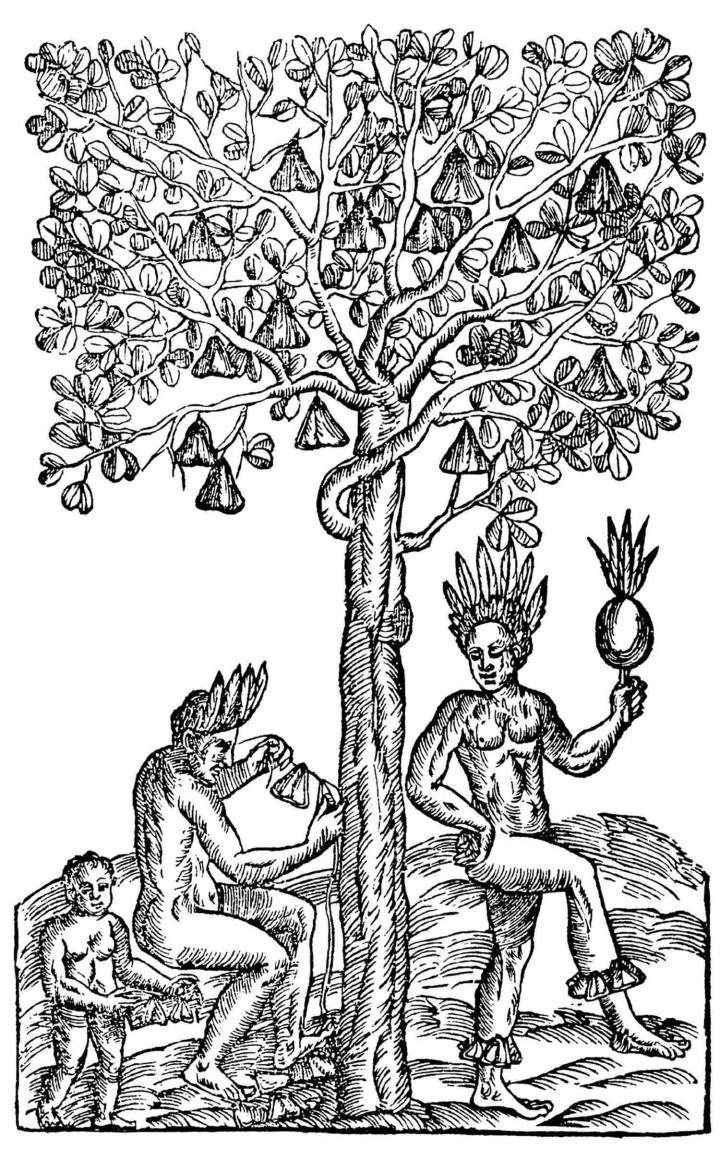“What is a myth? If you were to ask an American Indian, it is very likely that he would answer: It is a story about the time when humans and animals did not yet distinguish themselves from one another.”
Simultaneously inflaming both legend and record, Eduardo Viveiros de Castro floats this anthropological riddle from Claude Lévi-Strauss and Didier Eribon’s De près et de loin in his own “Perspectivism and Multinaturalism in Indigenous America,” part of the crystalizing, fracturing anthology The Forest & The School / Where to Sit at the Dinner Table? Organized as a range of thematic arguments on this fissure of nature and culture by its editor, artist and writer Pedro Neves Marques, the index surveys anthropological perspectivism, both formal—Bruno Latour, Félix Guattari, Davi Kopenawa, in addition to Brazilian anthropologists de Castro, Manuela Carneiro da Cunha, and Garcia de Rezende—and informal, such as German soldier Hans Staden’s 1557 account of his own capture and preparation for sacrifice while being held in captivity by the Tupinambá tribe. It is as much omen as historical, primary text: Narratives of animist uprising and counter-colonization have been foretold from the origins of Amerindian culture, and stand germane amid today’s hesitant efforts to contain industrial deforestation and neoliberal plague.
Antropofagia—cannibalization—had fully coagulated as artistic phenomenon by the twentieth century, with Francis Picabia’s 1920 “Manifeste Cannibale Dada” mirroring in European avant-garde circles what had already emerged in Brazil: Playwright Oswald de Andrade published Revista de Antropofagia, releasing numerous issues by the end of the decade. Films concerning the custom clustered in the middle of the century, attributable to postwar nationalism as much as the continental ascendancy of Tropicália. The populist, cross-disciplinary movement, easily transmittable through its flashing visual acidity and lush, humid melodies, advocated for anthropophagy both literally and creatively, resulting in works such as Nelson Pereira dos Santos’s Como Era Gostoso o Meu Frances (How Tasty Was My Little Frenchman, 1971). Soft campaigns against Western cultural influence by force led to Cinema Novo, a hyperrealist film movement that erupted half a generation later. Emboldened to take direct confrontation to one’s colonizer, they stylized violence without flinching from it.
Marxist influence within Cinema Novo is communicated with more precision as the movement matures, as Glauber Rocha, leading figure of Cinema Novo and director of its defining films in the mid-1960s — Deus e o Diabo na Terra do Sol (Black God, White Devil) and Terra em Transe (Entranced Earth) — writes “The Aesthetics of Hunger” and “The Aesthetics of Dreaming.” He details the instruments of his savagery in “Hunger,” describing a visual style dictated by physical necessity: the movement documents the violence that is to be expected of the starving, and says that it would be inaccurate to attribute the violence of the starving as primitive behavior. Violence is a language that would not be mistranslated.
This hunger is weighted significantly as a contributing factor; to acknowledge its depth is to draw a full form and identity of anthropophagy. Artist, architect and astute observer (described in his biography as an amateur anthropologist, but diaries of his expeditions to Indian communities left an extensive, important archive of film and photographs of the Indians’ first contact with outsiders) Flávio de Carvalho was ready: by 1956 he had designed the region’s “New Look” — a costume intended for São-Paulinos in their newly realized state: a breezy uniform of ventilated shirt and mini skirt, which addressed the realities of living in the tropics. His writing on hunger in the pages preceding Rocha’s forms a block of transcription on the reaches of this physical state. De Carvalho states plainly: “Religious feelings stem from the feeling of hunger.” If sustenance, a gift necessary for survival, is to be found, it must be divine, having been provided by a savior. The growing distance between human and resource, blocked by modernization’s complications, provides an answer for the question it has posed for itself before an ecosystem that had previously found this proposition irrelevant. Immediately following this grouping, Joaquim Pedro de Andrade introduces his 1969 film Macunaíma by proposing that cannibalism never went away — it simply morphed into our contemporary version of cannibalism: consumption.
Historicizing, and therefore underestimating, escape efforts from any stage of capitalism are futile, as this panorama illustrates for its readers. Activist Jean Tible, detailing the inevitable alliance of anthropophagy and Marxism in his text “Marx and Anthropophagy: Notes for a Dialogue Between Marx and Viveiros de Castro,” reminds us that these authorities do not grow in isolation, and neither are they extinct: “All had a taste of the other, except the executioner, who entered a period of reclusion and mourning.”


